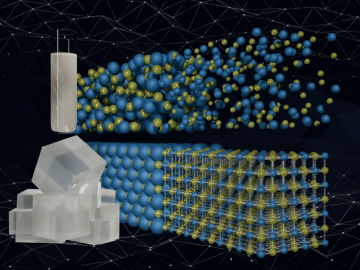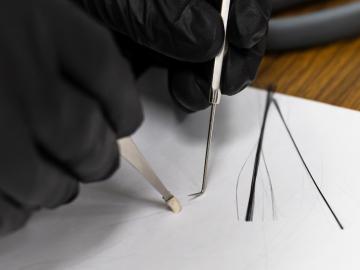
Filter News
Area of Research
- Advanced Manufacturing (5)
- Biology and Environment (59)
- Biology and Soft Matter (1)
- Computational Biology (1)
- Computational Engineering (2)
- Computer Science (8)
- Electricity and Smart Grid (1)
- Energy Science (54)
- Fuel Cycle Science and Technology (1)
- Functional Materials for Energy (1)
- Fusion and Fission (36)
- Fusion Energy (11)
- Isotope Development and Production (1)
- Isotopes (27)
- Materials (91)
- Materials for Computing (6)
- Mathematics (1)
- National Security (41)
- Neutron Science (26)
- Nuclear Science and Technology (41)
- Nuclear Systems Modeling, Simulation and Validation (1)
- Quantum information Science (2)
- Supercomputing (91)
News Topics
- (-) Artificial Intelligence (131)
- (-) Chemical Sciences (86)
- (-) Cybersecurity (35)
- (-) Element Discovery (1)
- (-) Frontier (64)
- (-) Isotopes (62)
- (-) ITER (9)
- (-) Machine Learning (68)
- (-) Molten Salt (10)
- (-) Nuclear Energy (122)
- (-) Physics (69)
- (-) Space Exploration (26)
- 3-D Printing/Advanced Manufacturing (146)
- Advanced Reactors (40)
- Big Data (79)
- Bioenergy (112)
- Biology (128)
- Biomedical (73)
- Biotechnology (39)
- Buildings (74)
- Clean Water (33)
- Composites (35)
- Computer Science (226)
- Coronavirus (48)
- Critical Materials (29)
- Education (5)
- Emergency (4)
- Energy Storage (114)
- Environment (218)
- Exascale Computing (67)
- Fossil Energy (8)
- Fusion (66)
- Grid (74)
- High-Performance Computing (130)
- Hydropower (12)
- Irradiation (3)
- Materials (157)
- Materials Science (158)
- Mathematics (12)
- Mercury (12)
- Microelectronics (4)
- Microscopy (56)
- Nanotechnology (64)
- National Security (86)
- Neutron Science (171)
- Partnerships (68)
- Polymers (35)
- Quantum Computing (53)
- Quantum Science (92)
- Security (31)
- Simulation (65)
- Software (1)
- Statistics (4)
- Summit (71)
- Transportation (103)
Media Contacts

A former intern for ORNL was selected to represent Tennessee presenting his research at the National Junior Science and Humanities Symposium. Langalibalele “Langa” Lunga, a senior at Farragut High School in Knoxville, Tennessee, interned with ORNL working on deep learning for fast scanning microscopy, a technique for capturing microscopic images more rapidly than traditional methods.

Scientists have developed a new machine learning approach that accurately predicted critical and difficult-to-compute properties of molten salts, materials with diverse nuclear energy applications.

Stronger than steel and lighter than aluminum, carbon fiber is a staple in aerospace and high-performance vehicles — and now, scientists at ORNL have found a way to make it even stronger.
Using the now-decommissioned Summit supercomputer, researchers at ORNL ran the largest and most accurate molecular dynamics simulations yet of the interface between water and air during a chemical reaction. The simulations have uncovered how water controls such chemical reactions by dynamically coupling with the molecules involved in the process.

Researchers at ORNL have developed a tool that gives builders a quick way to measure, correct and certify level foundations. FLAT, or the Flat and Level Analysis Tool, examines a 360-degree laser scan of a construction site using ORNL-developed segmentation algorithms and machine learning to locate uneven areas on a concrete slab.

ORNL’s Biological Monitoring and Abatement Program, or BMAP, is marking 40 years of helping steward the DOE’s 33,476 acres of land on which some of the nation’s most powerful science and technology missions are carried out.

UT-Battelle has contributed up to $475,000 for the purchase and installation of advanced manufacturing equipment to support a program at Tennessee’s Oak Ridge High School that gives students direct experience with the AI- and robotics-assisted workplace of the future.

Analyzing massive datasets from nuclear physics experiments can take hours or days to process, but researchers are working to radically reduce that time to mere seconds using special software being developed at the Department of Energy’s Lawrence Berkeley and Oak Ridge national laboratories.


Research teams at the Department of Energy’s Oak Ridge National Laboratory received computing resource awards to train and test AI foundation models for science. A total of six ORNL projects were awarded allocations from the National Artificial Intelligence Research Resource, or NAIRR, pilot and the Innovative and Novel Computational Impact on Theory and Experiment, or INCITE, program to train their AI models.


